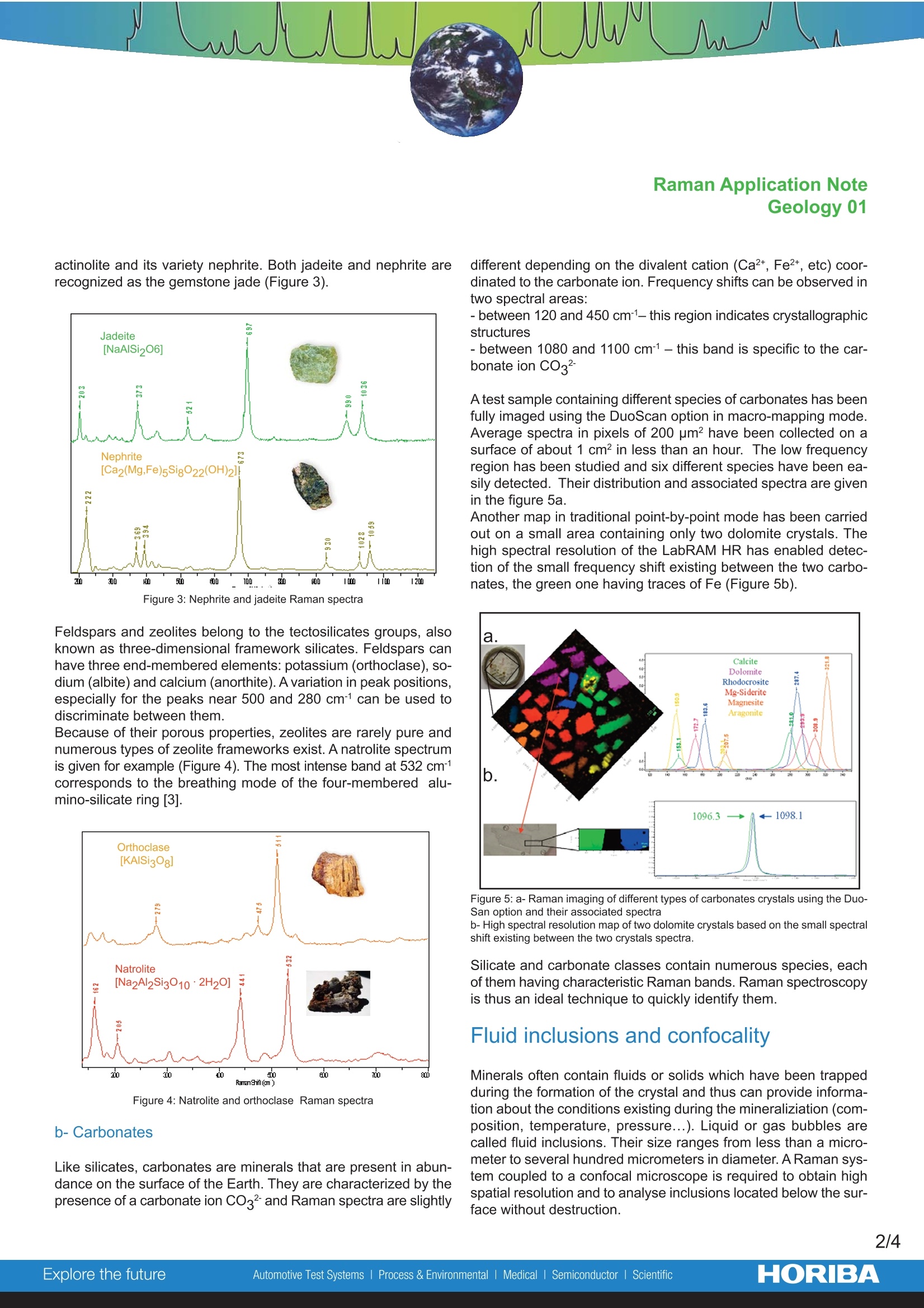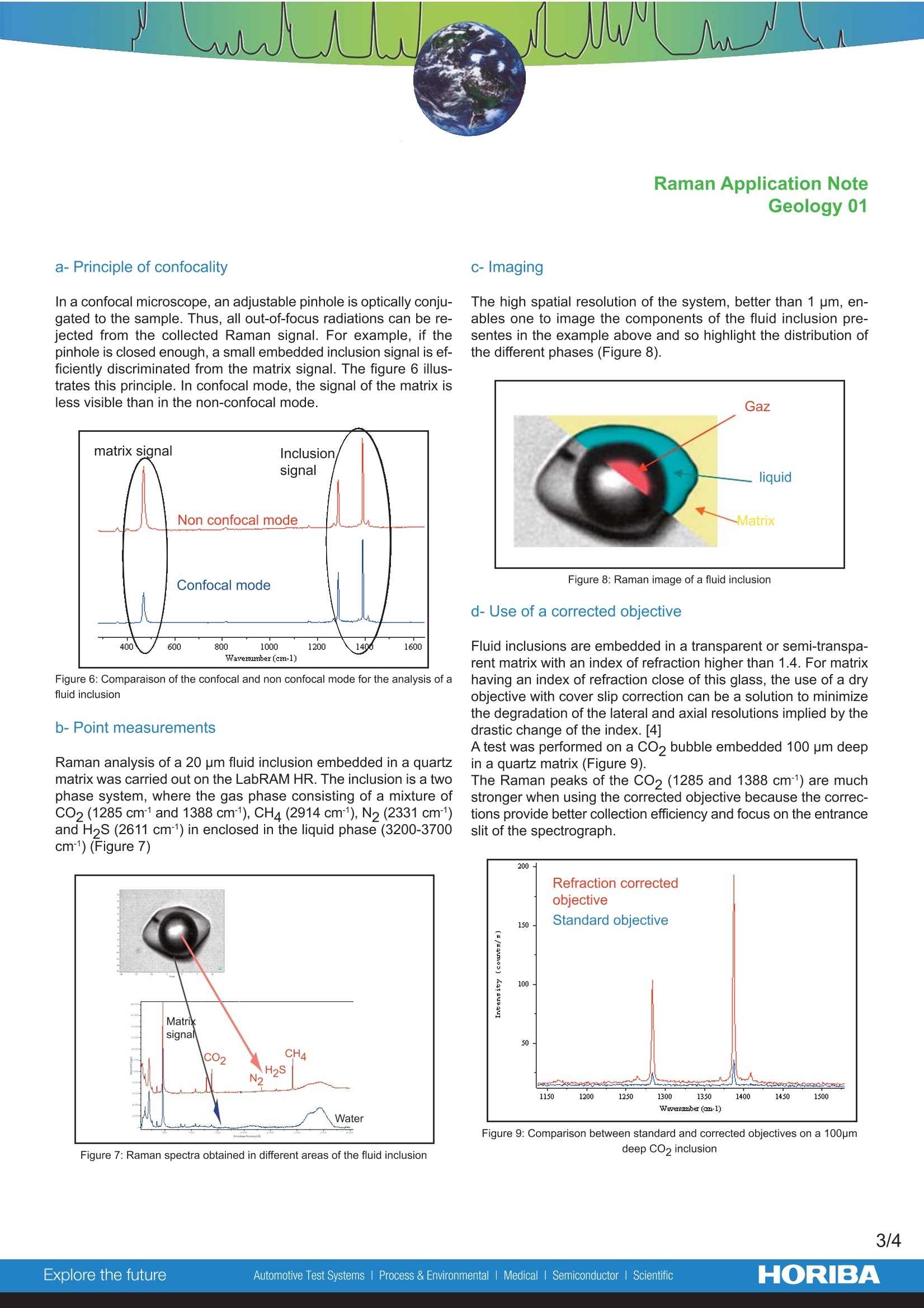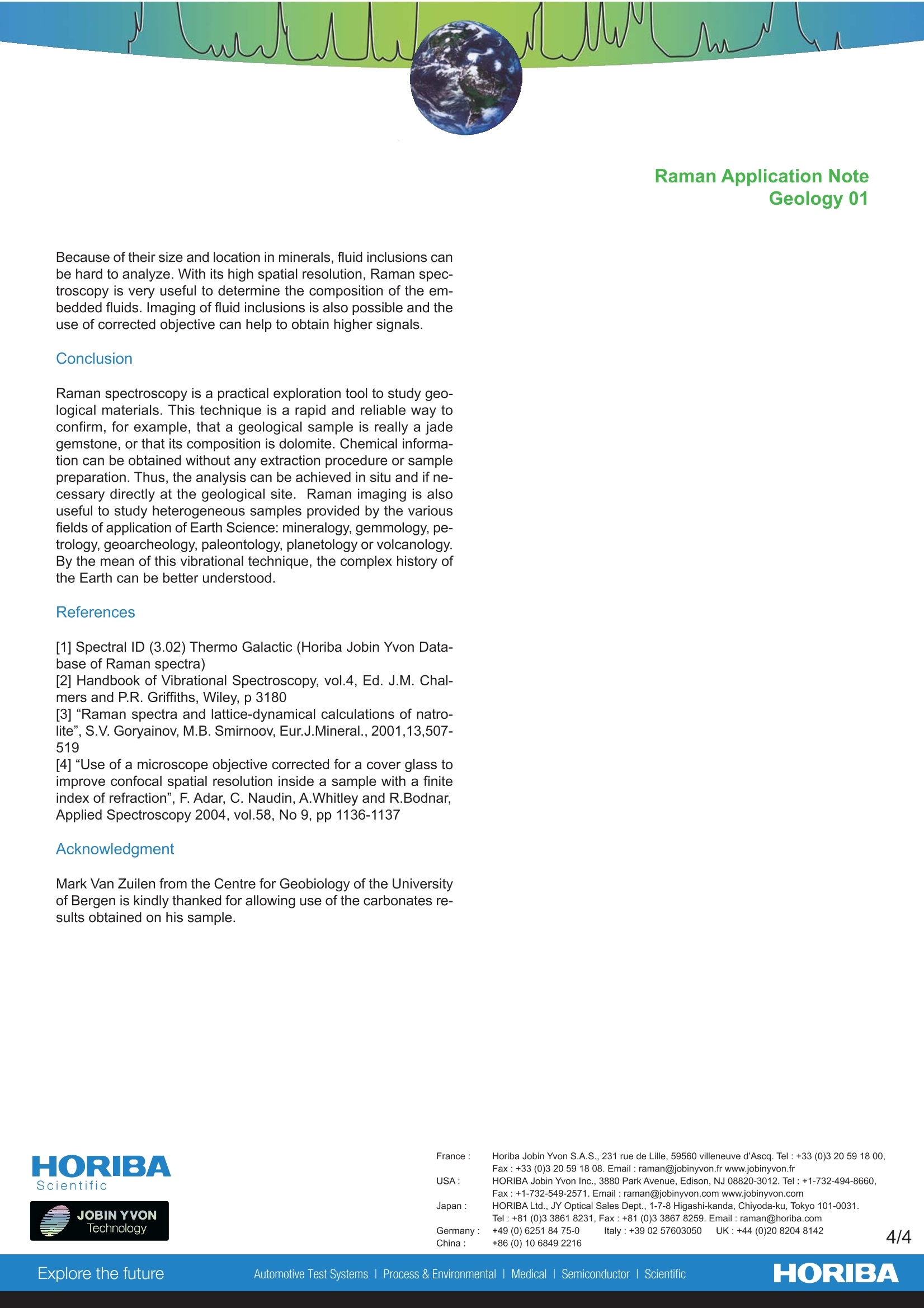
方案详情
文
Raman spectroscopy is a practical exploration tool to study geological materials. This technique is a rapid and reliable way to confirm, for example, that a geological sample is really a jade gemstone, or that its composition is dolomite. Chemical information can be obtained without any extraction procedure or sample preparation. Thus, the analysis can be achieved in situ and if necessary directly at the geological site. Raman imaging is also useful to study heterogeneous samples provided by the various fields of application of Earth Science: mineralogy, gemmology, petrology, geoarcheology, paleontology, planetology or volcanology. By the mean of this vibrational technique, the complex history of the Earth can be better understood.
方案详情

Scientific Raman Application NoteGeology 01 Raman Application NoteGeology 01 Raman Spectroscopy for Geological Materials Analysis Natural rocks composing the Earth are complex. They consist ofan aggregate of one or more minerals. Each mineral can be de-fined by its chemical composition and its crystalline structure andsometimes can also contain fluid inclusions. Geologists need apowerful characterization technique to get detailed information onthe rock formation history. Raman spectroscopy is extremely in-formation-rich (chemical identification, characterization of mole-cular structures, effects of bonding, environment and stress on asample). With its non-destructive properties and high spatial re-solution (<1 pm), it is thus a tool of choice for geological studies. Raman Spectroscopy specificities · The Raman effect is highly sensitive to even slight differences inchemical structures. Even if not all vibrations are observable withRaman spectroscopy (depending on the symmetry of the mole-cule or crystal), sufficient information can be obtained to discri-minate different structural groups or phases related to the samemineral class, like silicates or carbonates. · Sometimes a high spectral resolution is needed to resolve clo-sely spaced peaks. This is the case when specific pressure andtemperature conditions are applied to a mineral using for exam-ple a diamond anvil cell (DAC) to recreate what can happen deepin the earth. Indeed spectral discrimination will be the key factorto detect small peak shifts induced by high pressure and tempe-rature conditions. · Systems offering multiple laser excitations can efficiently coun-ter the possible fluorescence of geological samples. Coupled toconfocal microscopy, Raman spectroscopy provides informationwith high spatial resolution (<1 pm). ·On-site analysis can also be undertaken with mobile units pos-sibly by using remote sampling accessories. ·Raman spectral libraries are also a great help for easy identifi-cation of minerals, relying on supplier's libraries [1] or on data-bases created by the end-user. Chemical selectivity a- Silicate minerals The silicate minerals, often designated simply by the term “sili-cates", represent the most important class of rocks forming thecrust and mantle of the Earth. A silicate is a compound whoseskeleton is essentially composed of silicon and oxygen tetrahedraand with additional elements such as aluminum (aluminosilicates),magnesium, iron, calcium, potassium, etc. They are classified based on the mode in which the silicate groups coalesce. TheRaman spectra of the different classes of silicate minerals pro-vide rapid identification of the particular class. Figure 1 indicatessome of the arrangements of fused tetrahedra that are possible. Figure 1: Different tetrahedral arrangements Olivine is one of the most common minerals of the igneous rockstype (formed by magma). It belongs to the nesosilicates (or or-thosilicates) subclass characterized by an isolated tetrahedra[SiO4]4-. Its Raman spectrum shows intense stretching modes inthe 800-1000 cmregion and bending modes between 300 and650 cm²1. (Figure 2) Figure 2: Raman spectrum of olivine The term inosilicates is used for chain silicates. They are dividedin two groups: pyroxenes and amphiboles. Pyroxenes contain sin-gle chains of SiO4 groups. Like jadeite, their spectra present anintense Raman band between 650 and 700 cm1 [2]. In contrast tothe single chain structure of pyroxenes, amphiboles contain dou-ble chains of tetrahedra. One representative amphibole mineral is actinolite and its variety nephrite. Both jadeite and nephrite arerecognized as the gemstone jade (Figure 3). Figure 3: Nephrite and jadeite Raman spectra Feldspars and zeolites belong to the tectosilicates groups, alsoknown as three-dimensional framework silicates. Feldspars canhave three end-membered elements: potassium (orthoclase), so-dium (albite) and calcium (anorthite). A variation in peak positions,especially for the peaks near 500 and 280 cmcan be used todiscriminate between them. Because of their porous properties, zeolites are rarely pure andnumerous types of zeolite frameworks exist. A natrolite spectrumis given for example (Figure 4). The most intense band at 532 cmcorresponds to the breathing mode of the four-membered alu-mino-silicate ring [3]. Figure 4: Natrolite and orthoclase Raman spectra b-Carbonates Like silicates, carbonates are minerals that are present in abun-dance on the surface of the Earth. They are characterized by thepresence of a carbonate ion CO32and Raman spectra are slightly different depending on the divalent cation (Ca2t, Fe2t, etc) coor-dinated to the carbonate ion. Frequency shifts can be observed intwo spectral areas: -between 120 and 450 cm1- this region indicates crystallographicstructures -between 1080 and 1100 cm1- this band is specific to the car-bonate ion CO32- A test sample containing different species of carbonates has beenfully imaged using the DuoScan option in macro-mapping mode.Average spectra in pixels of 200 um? have been collected on asurface of about 1 cm2 in less than an hour. The low frequencyregion has been studied and six different species have been ea-sily detected. Their distribution and associated spectra are givenin the figure 5a. Another map in traditional point-by-point mode has been carriedout on a small area containing only two dolomite crystals. Thehigh spectral resolution of the LabRAM HR has enabled detec-tion of the small frequency shift existing between the two carbo-nates, the green one having traces of Fe (Figure 5b). Figure 5: a- Raman imaging of different types of carbonates crystals using the Duo-San option and their associated spectrab-High spectral resolution map of two dolomite crystals based on the small spectralshift existing between the two crystals spectra. Silicate and carbonate classes contain numerous species, eachof them having characteristic Raman bands. Raman spectroscopyis thus an ideal technique to quickly identify them. Fluid inclusions and confocality Minerals often contain fluids or solids which have been trappedduring the formation of the crystal and thus can provide informa-tion about the conditions existing during the mineraliziation (com-position, temperature, pressure...). Liquid or gas bubbles arecalled fluid inclusions. Their size ranges from less than a micro-meter to several hundred micrometers in diameter. A Raman sys-tem coupled to a confocal microscope is required to obtain highspatial resolution and to analyse inclusions located below the sur-face without destruction. In a confocal microscope, an adjustable pinhole is optically conju-gated to the sample. Thus, all out-of-focus radiations can be re-jected from the collected Raman signal. For example, if thepinhole is closed enough, a small embedded inclusion signal is ef-ficiently discriminated from the matrix signal. The figure 6 illus-trates this principle. In confocal mode, the signal of the matrix isless visible than in the non-confocal mode. Figure 6: Comparaison of the confocal and non confocal mode for the analysis of afluid inclusion b-Point measurements Raman analysis of a 20 um fluid inclusion embedded in a quartzmatrix was carried out on the LabRAM HR. The inclusion is a twophase system, where the gas phase consisting of a mixture ofCO2 (1285 cm and 1388 cm1), CH4 (2914 cm), N2 (2331 cm)and H2S (2611 cm1) in enclosed in the liquid phase (3200-3700cm1) (Figure 7) The high spatial resolution of the system, better than 1 pm, en-ables one to image the components of the fluid inclusion pre-sentes in the example above and so highlight the distribution ofthe different phases (Figure 8). Figure 8:Raman image of a fluid inclusion d-Use of a corrected objective Fluid inclusions are embedded in a transparent or semi-transpa-rent matrix with an index of refraction higher than 1.4. For matrixhaving an index of refraction close of this glass, the use of a dryobjective with cover slip correction can be a solution to minimizethe degradation of the lateral and axial resolutions implied by thedrastic change of the index. [4] A test was performed on a CO2 bubble embedded 100 um deepin a quartz matrix (Figure 9). The Raman peaks of the CO2 (1285 and 1388 cm1) are muchstronger when using the corrected objective because the correc-tions provide better collection efficiency and focus on the entranceslit of the spectrograph. Figure 9: Comparison between standard and corrected objectives on a 100pmdeep CO2 inclusion Because of their size and location in minerals, fluid inclusions canbe hard to analyze. With its high spatial resolution, Raman spec-troscopy is very useful to determine the composition of the em-bedded fluids. Imaging of fluid inclusions is also possible and theuse of corrected objective can help to obtain higher signals. Conclusion Raman spectroscopy is a practical exploration tool to study geo-logical materials. This technique is a rapid and reliable way toconfirm, for example, that a geological sample is really a jadegemstone, or that its composition is dolomite. Chemical informa-tion can be obtained without any extraction procedure or samplepreparation. Thus, the analysis can be achieved in situ and if ne-cessary directly at the geological site. Raman imaging is alsouseful to study heterogeneous samples provided by the variousfields of application of Earth Science: mineralogy, gemmology, pe-trology, geoarcheology, paleontology, planetology or volcanology.By the mean of this vibrational technique, the complex history ofthe Earth can be better understood. ( References ) ( [1] Spectral ID (3.02) Thermo G alactic (Horiba Jobin Yvon Data-base of Raman spectra) ) ( [2] Handbook of Vibrational S p ectroscopy, vol.4, E d . J.M. Chal-mers and P . R.Gr i ffiths, W iley, p 3180 ) [3]“Raman spectra and lattice-dynamical calculations of natro-lite", S.V. Goryainov, M.B. Smirnoov, Eur.J.Mineral., 2001,13,507-519 [4]“Use of a microscope objective corrected for a cover glass toimprove confocal spatial resolution inside a sample with a finiteindex of refraction", F. Adar, C. Naudin, A.Whitley and R.Bodnar,Applied Spectroscopy 2004, vol.58, No 9, pp 1136-1137 Acknowledgment Mark Van Zuilen from the Centre for Geobiology of the Universityof Bergen is kindly thanked for allowing use of the carbonates re-sults obtained on his sample. ( F ax: + 33 ( 0 )3 20 59 18 08. E mail : raman@jobinyvon.fr www.jobinyvon.fr ) ( USA: H ORIBA Jobin Yvon In c ., 3 880 Park A v enue, Edison, NJ 08820-3012. Tel : + 1-732-494-8660, ) ( Fax:+1-732-549-2571.Email : raman@jobinyvon.com www.jobinyvon.com ) ( Japan : H ORIBA Ltd., JY Optical Sales D e pt., 1-7-8 Higashi-kanda, Chiyoda-ku, T o kyo 101-0031. ) ( T el : +81 (0) 3 386 1 8231 , Fax: +81 (0)3 3867 8259 . Emai l : raman@horiba.com ) Germany : +49(0)62518475-0 Italy: +39 02 57603050 UK : +44 (0)20 8204 8142 China : +86(0)10 68492216 Explore the future ORIBAExplore the futureAutomotive Test Systems Process & Environmental MedicalemiconductorScientific Raman spectroscopy is a practical exploration tool to study geological materials. This technique is a rapid and reliable way to confirm, for example, that a geological sample is really a jade gemstone, or that its composition is dolomite. Chemical information can be obtained without any extraction procedure or sample preparation. Thus, the analysis can be achieved in situ and if necessary directly at the geological site. Raman imaging is also useful to study heterogeneous samples provided by the various fields of application of Earth Science: mineralogy, gemmology, petrology, geoarcheology, paleontology, planetology or volcanology. By the mean of this vibrational technique, the complex history of the Earth can be better understood.
确定




还剩2页未读,是否继续阅读?
HORIBA(中国)为您提供《地质材料中化学组成检测方案(激光拉曼光谱)》,该方案主要用于其他中化学组成检测,参考标准--,《地质材料中化学组成检测方案(激光拉曼光谱)》用到的仪器有
相关方案
更多
该厂商其他方案
更多








